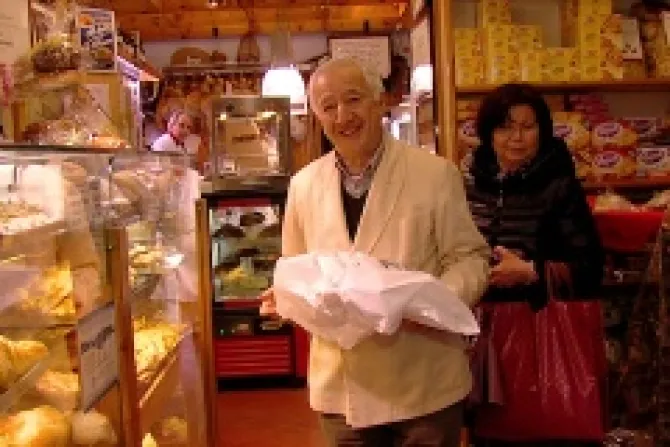Rome, Italy, Mar 30, 2013 / 07:24 am
Italians are known for their food, and at Easter time one Roman baker is putting his craft on display by making cakes to commemorate Saint Peter's Basilica and remind people of the Holy Spirit.
"We call it 'Cupolone' (dome) to recall Catholicism and the Holy Spirit," said Angelo Colapicchioni, an Italian baker who grew up next to the Vatican.
The big sweet cakes have a similar texture to bread but with a faint taste of orange and are topped with almonds and thick grains of flaky sugar.
"We make them with flour, fresh eggs, butter, candied orange and citrus peels, and almonds from Sicily," said Colapicchioni.
They are traditionally made each year at Easter time in Italy and are better known as "Colomba," or doves, since they come in the shape of a dove.
"We are particularly tied to this area (the Vatican) with affection," he told CNA on March 27.
The 77-year-old Roman grew up on Borgo Pio, a street that ends at one the entrances to the Vatican, and he used to see Pope John XXIII walking in the area.
The baker compared him to Pope Francis, whom he described as "very human" and someone that "breathes trust."
"Like John Paul II, they are people who are very loved by the people because they are close to the people," said Colapicchioni.
His father opened the Colapicchioni bakery in 1934 and the business now has two stores with around 23 employees. The original location is on Via Tacito near Castel Sant'Angelo and it specializes in local artisan products like jams and wine from the Lazio region.
The second store, on Via Properzio near the Vatican Museums, is where six bakers dedicate themselves to creating the delicious Italian cakes and desserts that are traditionally eaten at Easter time.
His bakery, which is known simply as "Colapicchioni," is nearly 80 years-old and sells hundreds of the handmade cakes each Easter.
Romans also eat "pastiera" during Easter, a cheese cake traditionally made in Naples.
"But we use ricotta cheese from Roman sheep and some flavoring but it's very delicious because it's a very delicate sweet," Colapicchioni said.
"The 'pizza romana' is another Easter sweet that we make as well as the 'casatiello' and Easter chocolate eggs," he added.
The casatiello is a dish eaten on Easter morning and is composed of cold cuts topped with eggs inside their shells.
"Italians remain tied to certain traditions because even in times of crisis they may eat less, but they still buy these typical Easter products," said Colapicchioni.
They also buy "pizza di Pasqua" – a salty yellow bread with cheese – and "salami di felino," a specific type of salami from the Parma region.
"They may buy less but they are never missing on Italian tables on Easter day," he added.
According to the baker, Italians used to go out on picnics on the Monday after Easter.
"But we are losing this tradition because now there are people who go to the taverns or stay home," said Colapicchioni.


